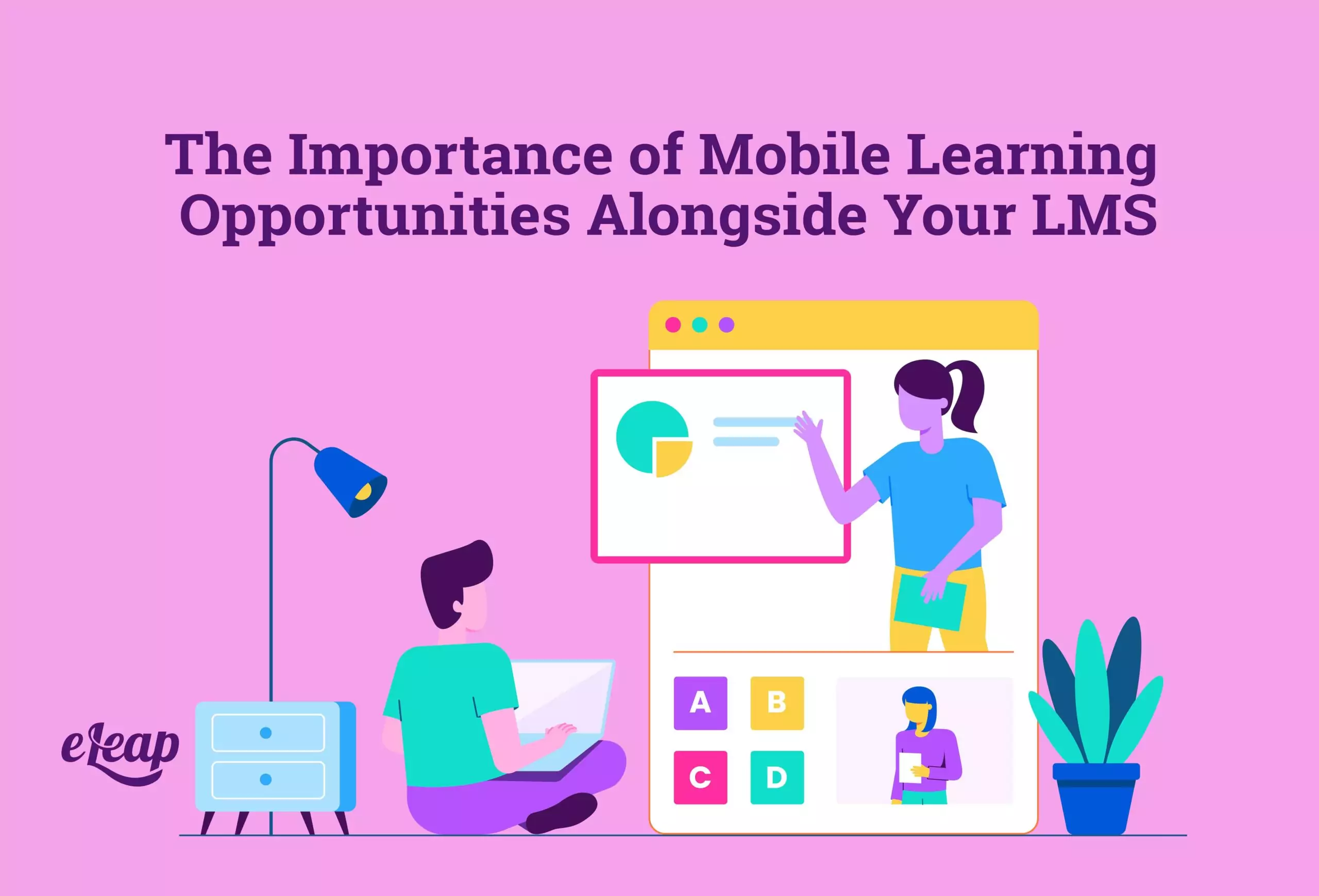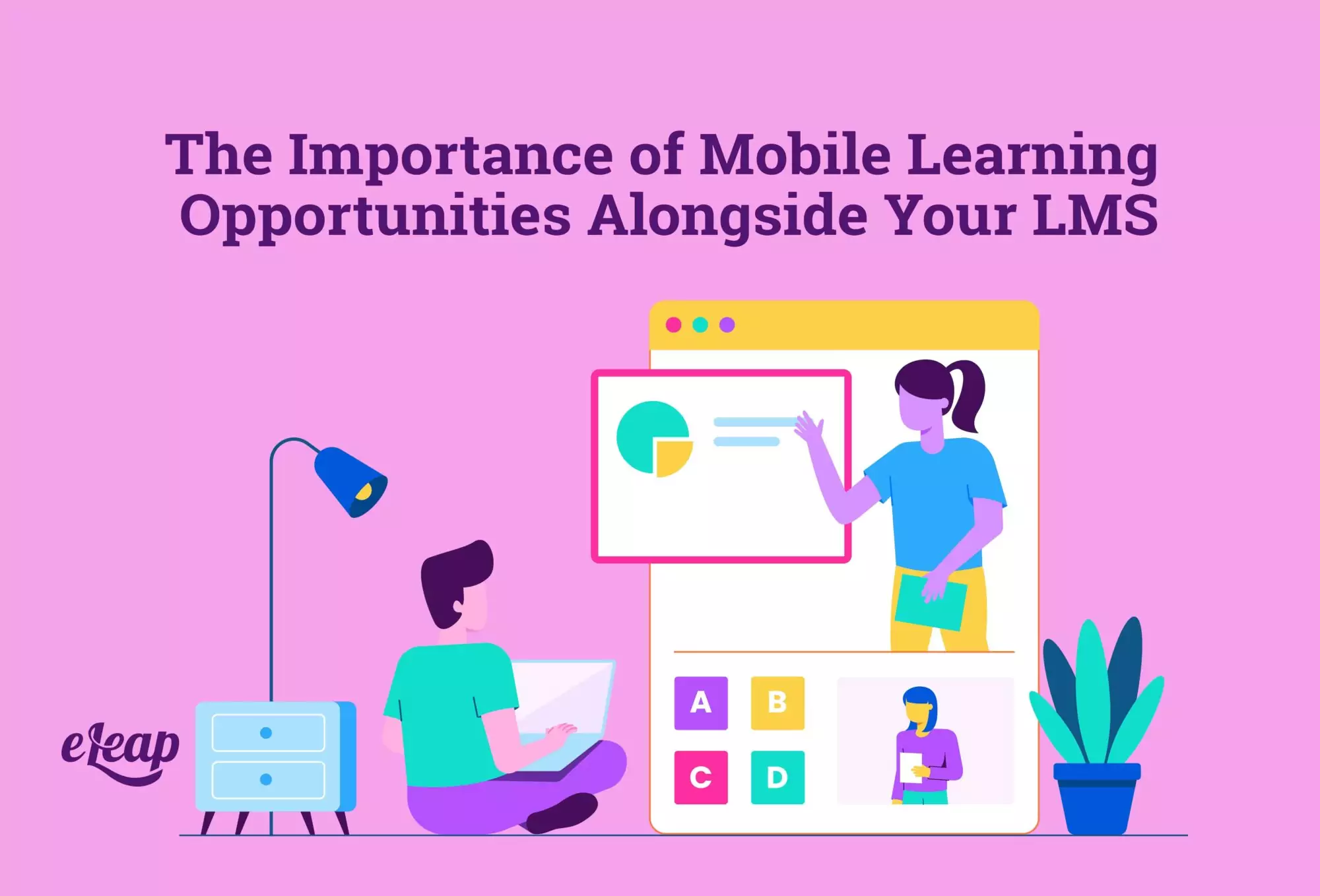The Importance of Mobile Learning Opportunities Alongside Your LMS

There is a time and place for employees to sit down at a computer and take a training course or attend a virtual educational seminar. However, there is also a time and place for more focused learning that is in line with their everyday routines—including their mobile Internet browsing and social media scrolling. Thus, it would stand to reason that if an LMS was truly going to deliver everything today’s employees need, it would have to include mobile access with micro-learning opportunities and development tracking on the go.

What is Mobile Learning? Is it Different from eLearning?
In some ways, mobile learning is similar to eLearning in that it provides digital access to educational resources. However, it’s much more agile and flexible, considering that it has to be engaging on mobile devices and keep learners on track. The benefit of mobile learning apps, of course, is that they can fit easily into your employees’ lifestyles. And for employees who don’t spend their days sitting behind desks, this is one of the most useful learning options.
Mobile training courses and programs are available with multiple formats of content and delivery methods. Distractions can be high with mobile learning, of course, so these programs are often created with microlearning opportunities that ensure that everyone is on the same page. Mobile content needs to be much more engaging and designed to be interacted with in much shorter intervals. Whereas an employee might watch a 20-minute webinar on their office computer, they might only have the time (or attention span) for a quick refresher video or even a gamified review of recently learned content.
However it’s done, so long as it’s done with best practices in mind, mobile learning stands to offer plenty of performance improvement from new hires on through your most seasoned employees.
How Mobile Learning Improves Performance
There are several different ways that adopting mobile learning opportunities can help an organization improve its performance. Below are a handful of the biggest benefits.
Mobile learning makes on-the-job education easy.
It’s hard to learn something from a book when it requires a practical application. With computer learning, employees often aren’t able to access their courses or instructors when they’re actually on the job. Some companies will do practical application sessions, but those can be limiting, as well. When organizations adopt mobile learning, it’s much more similar to on-the-job training and upskilling.
Employees can use the mobile course or app as a guide while they’re working in their actual role, offering the chance to immediately apply what they’ve learned. When it comes to practical and manual tasks, this is a huge asset.
It intervenes at the exact point of need.
Mobile courses are smarter and more agile than eLearning courses offered on a computer. Employees need easy access and quick answers, which is where mobile learning courses come in handy. These can be used as refreshers, to help people with specific tasks, and so much more. Instead of having to learn the skills or information in a static training session and then try to take them to the field, people will get the knowledge and training they need exactly when they need it.
Mobile learners are more engaged with courses.
Even though eLearning has created a lot of new opportunities, there’s the fact that it’s still computer-based learning. That sometimes will be an immediate turn-off for learners. They picture dated training modules of old and sitting in front of a computer for hours, even if that’s not the reality—it’s difficult to get people to engage. Not only that but if you ask them to do this training as additional work, they’re not going to feel very good about it.
People have short attention spans, but they love mobile apps. They will also love that the learning is right in their hands, and they can make time for it as they see fit. When people are given this kind of control and accountability over their training, it will definitely change their perception of it and cause them to engage more.
Everyone can access training resources.
Of course, the biggest part of employee training and performance is that everyone has access to the training tools and resources. With field employees and deskless workers in the past, that was not always the case. Sometimes, these people miss out on valuable training simply because of their work position or location, which could hamper their ability to succeed and grow on the job.
With mobile apps for learning and training, every single employee will be able to learn and develop no matter where they are. This will lead to people working more efficiently and offering more loyalty because they’ve been given the chance to improve their skills or re-skill on old jobs. Regular training on mobile devices will help you keep employee enthusiasm and motivation high.
Collaborative Learning, Gamification, and More
Formal training can be difficult to administer, and, in some industries, it might not even make much sense. Classroom training for first-line customer service reps? Why not real-time interactive training or some VR programs to give them real interaction? And why not do it on mobile?
Offering a place where people can learn together, learn from each other, and enjoy doing it is going to change the game for your employee training and development entirely. There’s so much that you can do with mobile training in these realms that it can shift things for your organization’s L&D.
The Future is Mobile, and the Future is Now
Anyone still on the fence about mobile learning and training opportunities needs to do some more research. Even a simple poll of employees could help leaders see how much value can be found in mobile training and learning opportunities. Whether this is an extension of the LMS or another app or training solution entirely, you can integrate it all so that performance tracking is simple, and employees know exactly what’s expected of them from their learning and development within the organization.